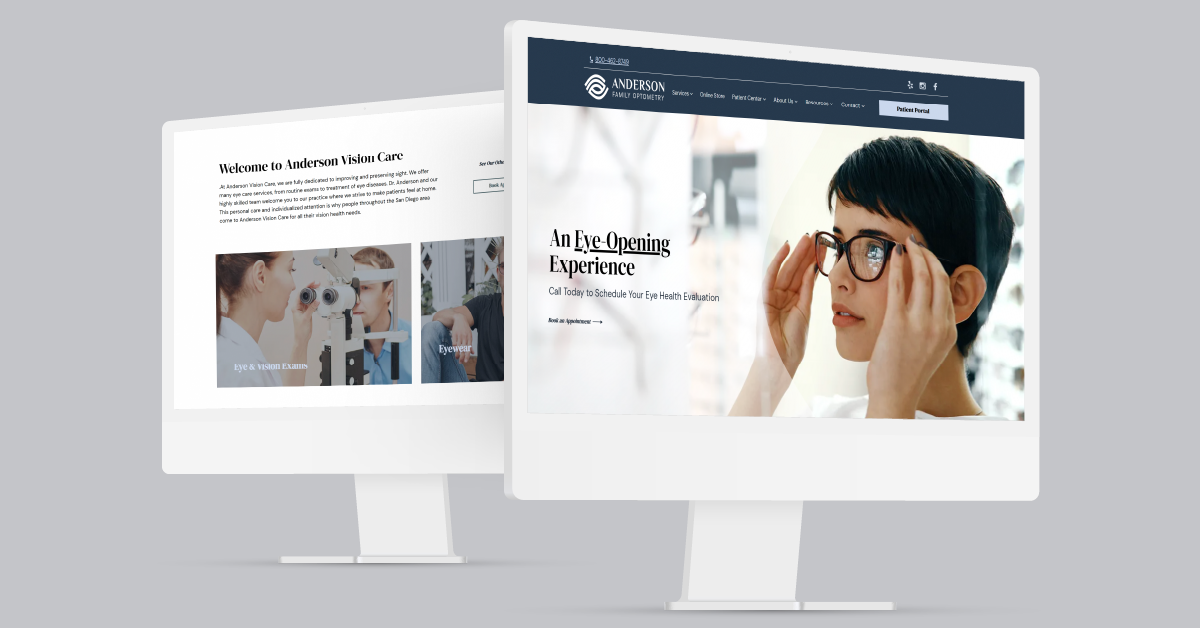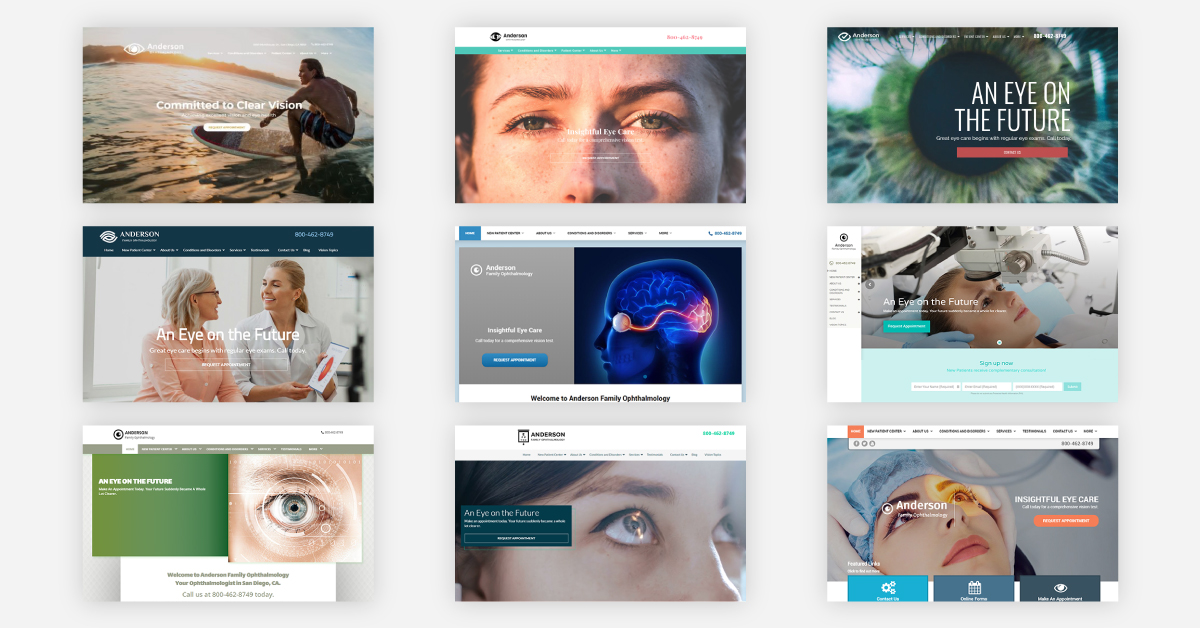How to Revamp Your Website: Tips to Follow + Checklist

Regardless of your industry, having a stellar website design is crucial in helping increase your conversion rates and website traffic. When someone visits your practice’s website, do you honestly think they’re impressed by your existing website? You should understand what works and what doesn’t work on your website among your target audience.
Perhaps it’s time to consider a website redesign. User experience is one of the most vital aspects of revamping one’s website. Every decision you make on your website redesign should answer this crucial question: Does this change enhance the experience for my clients?
If a user visits your website, they should be able to navigate quickly and eventually reach your service and appointment request pages. So, how do you ensure your business website is designed for the best user experience? We’ll discuss tips you should consider as you develop your new website and a quick checklist to determine if you’re due for a website redesign.
User experience is one of the most important aspects of revamping your website. Every decision you make on your website should answer the question ‘does this change enhance the experience for my patients or clients?
The Best Ways to Revamp and Improve Your Website Design

Which aspects should you pay attention to during your website redesign process? Revamping your website is something that takes time and strategy. Here are some helpful tips as you breathe new life into your current website:
Analyze Your ‘Old’ Website
Before you devise a stellar website redesign strategy, you should take time to analyze your existing website design. With the help of tools such as Google Analytics, you can inspect your website’s data. Identify which pages are most popular among your website visitors and which call-to-action buttons resonate most with your audience.
It would help if you remained objective as you analyzed your entire website. You should determine your website’s pain points and address them during your website revamp process. While it can be challenging to admit that you were ineffective in some aspects of your website design, it’s all part of the learning process. Moreover, while elements of your website may have been relevant when you first set up your website, they may not apply to today’s digital landscape.
Note Your High-Performing Assets
While your current web design may not be perfect, it is not entirely ineffective. As you identify your website’s flaws, you should also note your strengths. This is primary because you don’t have to completely transform everything during the website revamp process. You may not have to touch your best-performing assets at all. Losing their effectiveness may damage your digital marketing strategy irrecoverable. After all, these assets may best define what makes your practice unique.
What kind of assets should you be on the lookout for, exactly? These assets may include the following:
- Most viewed or shared content
- Website pages with the highest traffic
- Highest-ranking keywords and associated pages
- The number of inbound links to individual website pages
If you tap a web designer to handle your website redesign, they might not even consider this step because they’re neither digital marketing experts nor SEO specialists. You shouldn’t hesitate to remind them about this.
Define Your New Strategy
Before you devise a winning website redesign plan, you should consider why you need a website redesign to begin with. As you plan your next steps, it would be ideal to outline your goals precisely. Plenty of stellar website design elements can take any website to the next level, but the question is: Will these elements help you reach your objectives?
Moreover, you may not have the budget to include all the latest technologies in web design. This is why you should make a priority list of which elements align with your goals the most. As you develop your website redesign plan, you should consider precisely what you want to achieve.
Here are some goals to consider for your strategy:
- Lower your website visitors’ bounce rate
- Make your library of information more accessible
- Develop more educative website pages
- Become more visually aligned with your brand identity
- Improve website navigation to average more pages per visit
- Enhance on-site search engine optimization efforts
For every goal you identify, you must define a strategy to achieve it. This process effectively identifies the elements you need in your website redesign strategy. It also determines which features shouldn’t be on your top priority list.
Identify Your Customer Persona
You should remember something as you redesign your website: Your website redesign project isn’t all about you. In fact, it’s hardly about you. When users visit your existing site, they probably think, ‘What’s in it for me?’ or ‘How can this help me?’
As you progress in your redesign project, you should never forget to speak to your target audience in a way that appeals to their customer persona. How can you resonate with them more? Your website revamp should be geared towards the direction that would make them want to explore your website more.
Your customer personas allow you to determine how to shape your website redesign game plan around the visitors that matter most. Your branding and content should align with your target audience. Your target audience may be more than one customer persona, so you should keep this in mind. Since you started your business, your customer behavior may have changed dramatically, too. Identifying your customer persona(s) allows you to streamline your efforts effectively.
Check Your Competition
While you shouldn’t obsess over what other businesses are doing, it would be best to know how you compare. Checking what your competitors are doing allows you to take your own website to greater heights. Many free website analytics tools can help you analyze your competitors’ website performance.
Competitive analysis gives insight into which aspects you can improve during your website redesign process. Some elements might hinder you from achieving your objectives, and you would only realize this when you check what others in the industry are doing.
Once you identify your competitors’ strengths and weaknesses, you can compare them with your current website. Your new website should capitalize on your strengths and take advantage of some weaknesses your competitors have. This process helps you realize what you like and don’t like. Moreover, you can take inspiration from what makes their website attractive and improve from their best practices.
Choose Your Color Palette

When choosing the new color palette for your new website, you should consider the hues complementing one another. You’ll use these shades for your company logo, web pages, and other branding materials. Hence, you should ensure they’re harmonious with one another.
As you go about your website redesign planning, you should determine color. This is the first color to draw people’s attention as they visit your website, so choose a hue carefully.
Colors affect people and have the power to make website visitors feel certain emotions. This sensation is called color psychology. Each color invokes receptors in the human brain that associate that color with a particular emotion. Here are some colors, for example:
- Yellow – optimism, youthfulness, and warmth
- Orange – friendliness, confidence, and creativity
- Red – boldness, passion, and excitement
- Pink – sweetness, romance and femininity
- Purple – success, wisdom, and imagination
- Blue – stability, trust, and calmness
- Green – growth, health, and peace
- Gray – neutrality, balance, and simplicity
- Black – sophistication, elegance, and power
Effects of Color Explained
After reviewing the psychological effects of each color, you need to decide which of them best represents your business and your brand. Moreover, you should consider which colors can help you reach your target market.
For example, if you lead a chiropractic practice, you may want to choose colors like blue, which is often associated with healthcare. Blue represents healing, peace, and growth, as your patients attempt to improve their conditions, blue is a calming color. Grey is another option, signifying balance. You must thoroughly understand your ideal patient and what they will relate to so you can choose hues that will appeal to them the most.
Another contrasting color is red, which is often found in many fast food chains from Mcdonalds’, Carl’s Jr., Wendy’s, etc. Why does red work so well? It’s a bold color associated with passion but it can also trigger hunger and effectively attracts attention. For an optometry practice red would most likely not have the best effect.
Your chosen dominant color should be used in limited spaces throughout your website. If you want to draw your visitor’s attention to a particular link or call to action, use your dominant color for that. Once you’ve determined your dominant color, it’s time to choose the accent ones.
Your website shouldn’t be monochromatic; you should mix and match well. Your accent colors should be utilized to draw attention to secondary information on your website.
Your new website shouldn’t have more than two accent colors because you want it to appear as organized and professional as possible. If there are too many colors on your website redesign, visitors won’t be sure where to pay attention to your website.
Add Visual Elements
Did someone say pictures? We surely did! Photos are a surefire way to draw your ideal target market to your website. If most of your web design is text-based with little to no graphics, most people won’t be interested in exploring your website and will likely click exit. Regardless of how compelling your text is, this may increase your bounce rate.
If no images or videos break it up, people will get weary from skimming through your text. A stellar photo or video can help visitors better understand your content.
Visuals add some personality to your content. You want website readers to feel like they know your business personally, and graphics give you that pop of familiarity you need. Whether you’re using stock images or original ones, you should ensure they are high-resolution and look excellent on your website when blown up. Maintaining high standards for each visual on your website will help impress visitors with each imagery.
Visual elements aren’t limited to stellar photos. You can upload high-resolution videos and infographics for your audience to learn more about your business and how your services can add value to their lives. Videos can create a lasting impression on people and can help market your brand further.
Create A Blog

Starting a blog for your business is one of the easiest ways to get your content to reach your target market. Do you want to know the best part? It’s completely free! Cost-effective and help increase website traffic? What a no-brainer!
The content of your blog articles should be relevant and informational to your readers. Each blog post should feel like they’re learning something new. This would compel them to read more of your content as you share more articles.
If they’re interested in your blog content, they’ll subscribe and add to your existing email database. From there, you can also send them newsletters, content downloads, or any other content you create. Creating a blog page for your website redesign also gives you a chance to:
- Gain more visibility online
- Teach current and potential patients about your services
- Improve your lead generation efforts
- Get more social media exposure via content sharing
To position your practice uniquely from other businesses in your area, you should use your blog to educate and entertain your audience. Your blog may also help your website rank higher on search engines.
Steps to Optimizing Your Website
If you want to increase your organic ranking on search engines like Google and Bing, you should optimize each of your website pages. This process includes inserting keywords into titles, meta-tags, meta-descriptions, and the content on your web pages.
1. Make Website Mobile Responsive

Optimize your website design to look its best on multiple devices and more.
While many people still surf the internet on their computers, more and more people use their mobile devices for their online needs. This sentiment especially rings true when a person is searching for a clinic in their area that can treat their health condition.
Your website should change the font, graphics, and other elements to compensate for every screen size. Search engine results can negatively downgrade a business website not set up for mobile devices.
When optimizing the mobile version of your website, you should declutter the screen and remove unnecessary elements. This ensures that the vital parts stand out on the smaller screen. You may also consider mobile website design features like branded welcome screens or animations in your redesign.
Making your website mobile-friendly cannot be highlighted enough. Why? Google uses mobile-first indexing to rank websites. Hence, optimizing your website for mobile devices can take your SEO efforts to the next level.
2. Inject the Latest Website Elements
Your website design developed in 2013 may not be relevant to the audiences 2023 and beyond. You should include the latest tools in your website redesign strategy to elevate your business. From intuitive navigation to chatbots and interactive elements to personalized content, your new site should include new features to improve visitors’ user experience.
For example, adding an interactive map to your website redesign enables more people to find your practice efficiently. Chatbots can help users find the information they need quickly and can encourage them to sign up for your newsletter. Your website redesign is a stellar opportunity to follow web design trends that may benefit your business.
When choosing which trends to follow, consider which ones are relevant to your business. You should focus your budget on elements that are of value to you and help you reach your business goals. Fortunately, technological advancements have made it more accessible for businesses to inject the latest elements into their website redesign. Discuss with your web designers or web design agency which ones apply to your company and see if they fit your overall budget.
3. Keyword Research

You can use tools like Moz for keyword research and discover industry-specific terms relevant to what your patients are likely searching for when looking for a business like yours. Here are other vital steps you should take to optimize your existing website:
- Write long-form content – Buffer recommends around 1,600 words per blog articles
- Fix broken links – If you have links on your current website that lead to 404 error landing pages, you need to update or replace them as soon as possible because they can harm your SEO efforts.
- Build backlinks – A backlink is when someone uses your website as a resource for content on their website. Backlinks allow your business to build credibility and position you as a trustworthy authority figure in the industry. The more other websites reference yours in their respective content, the more credible you appear to search engines.
Search engine optimization allows you to boost your authority and fosters trust between you and website visitors. The better your SEO, the more likely Google will suggest your content to users and include your website on their results pages.
4. Include Calls to Action Strategically
Website redesign projects aren’t conducted to give your website a facelift and make it prettier simply. It’s meant to help your company website convert leads and attain your goals more efficiently. How can your business benefit financially from a website redesign? It would be best to encourage more users to act on your website.
From appointment bookings to purchasing items from your online store and subscribing to your newsletter to sending your office an inquiry, each website page should encourage users to perform a specific action. Your call-to-action for each web page should be relevant to its content. Otherwise, adding random buttons on your website redesign wouldn’t make sense. For example, if your website content discusses the benefits of a new service or product, your call to action should be to book an appointment for that service or a contact form so people can ask more about it.
Thus, during your website redesign process, analyze which action you would want a user to make ideally. While you may entrust your site redesign to digital experts, you should be hands-on in this part because you would understand your business better than anyone else.
5. Ensure Branding Consistency

At the root of branding consistency, the most vital thing to remember is that every message you send should emulate your core values as a business. Using the same color palette, voice tone, similar visual elements, and more will establish your brand in your ideal market.
Keep your branding in mind when you revamp your website. Once you finish your website enhancement, your updates should be reflected in all your marketing collaterals for your practice. The look and feel of all your marketing materials should be consistent to appear professional.
Let’s say you develop a list of tips for your patients. You want the colors of the tip sheet to coincide with the color palette of your website redesign. You should also review and revamp your old marketing materials to suit your new website. Stay consistent with your branding so your business becomes easily recognizable through your messaging and designs.
6. Optimize the Site for Speed
Did you know that you only have two seconds to convince a website visitor to stay on your website? Every second counts when improving your website. If your website takes too long to load, you increase your bounce rate significantly.
If your web pages take too long to load, you may need to delete or update particular plug-ins, large files, redirects, or anything else that could slow your site down. You may also explore moving to a performance-enhanced hosting solution. Moreover, you should ensure the site loads fast on various devices.
7. Update Content Regularly
Your website redesign efforts don’t stop once your new website goes live. From time to time, you should evaluate your website performance and tweak it if necessary. Moreover, you should regularly upload fresh content so your visitors will visit your website for expert advice.
You shouldn’t just add new content regularly. You should also update old content if new data or updates are available. Some minor changes can improve your SEO efforts and ensure your content remains relevant. Adding strategic keywords can help blog articles rank higher on search engine results. The little things can go a long way.
Revamp Website Checklist: How Do You Know if Your Website Design Needs to Be Updated?

So, how do you know it’s time for a website redesign? Before you contact a web designer, you should ask these questions?
Is Your Website Mobile-Friendly?
Don’t continue forcing website visitors to zoom in and out or pinch the screen to read something on your website. As mentioned, your website needs to be mobile-responsive and adjust to multiple devices.
How Are Your Bounce Rates?
Do your website visitors stay on your site for a long time, or do they stay there shortly? If they click exit as fast as they open your website, you’re due for a website redesign.
Is Your Website Organized?
Can website visitors quickly locate your website pages and find what they’re searching for? They should be able to see what they need with the least number of clicks possible.
How Long Does It Take for Your Website to Load?
Most internet users won’t wait more than two seconds for a website to finish loading. If it takes longer than that, you need to make some changes.
Is Your Website Aesthetically Pleasing?
Updating your website every few years is crucial to stay up-to-date with current website trends. You wouldn’t want your website to appear antiquated and irrelevant. Research current web design trends that you could implement on your site.
How Relevant Is Your Content?
There is a constant emergency of new information, and your content should keep up with the times. If your entire content catalog is old and outdated, you may have to scrap it and start fresh.
Is It Time to Revamp Your Practice’s Existing Website?
Are you keen on applying these website redesign tips to your business? It can be challenging taking on your website redesign project alone. You can give your professional website and makeover and attract more clients by calling us today at 800.792.8384. You can also click here to learn more about our website services.
FAQs
When should I revamp my website?
It is recommended to have a website redesign every two to three years. If you haven’t revamped your website for more than three years, you should do so.
What are the objectives of a website revamp?
Companies explore website redesign for various reasons. The most common ones are site rebranding, increasing one’s website traffic, and improving user experience functionality.
What is the difference between revamping and redesigning a website?
The main difference lies within the project’s scope. A website redesign changes most or all elements of a website, while a revamped website replaces a few elements only.



